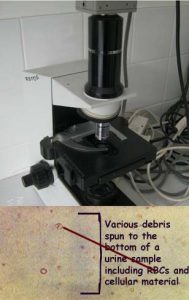What Caused Increased Sediment In My Dog Or My Cat’s Urine?
This article has nothing to do with Sed rate
Ron Hines DVM PhD


Why Might Microscopic Sediment That Should Not Be There Be In My Dog Or Cat’s Urine?
When your veterinarian asks you to bring a specimen of your cat or dog’s urine for analysis (urinalysis); looking under the microscope for objects and things that shouldn’t be there is a very important part of the process. Generally, a test tube full of your pet’s urine is first centrifuged to drive all solids within it (“the pellet”) to the bottom of the tube. Then that sediment is examined under a microscope. Normal urine is generally quite low in visible and microscopic material and debris. Sometimes, the examination procedure is left to a central veterinary laboratory to perform. Whichever the case, the sample must be fresh or quickly refrigerated for the results to be accurate.
It is normal for the pellet of material to contain some mucus and cells that have dislodged from the walls of your pet’s bladder (transitional epithelium cells).
When your veterinarian finds more than a very few red blood cells (RBCs), the presence of more than a few white blood cells (WBCs), increased debris or cells that have sloughed from the tubes and ducts that convey urine (=casts) or the presence of bacteria or crystals, careful consideration is needed to see if they might be a part of the reasons you brought your pet to your veterinarian in the first place. The test is also very helpful in picking up urinary tract issues before symptoms are noticeable to cat and dog owners.
When your veterinarian noticed that your pet’s urine was not crystal clear (i.e. turbid), microscopic examination of the urine sediment for the cause of that turbidity becomes even more important.
Some Of The Abnormal Sediments That Might Be Found In Your Dog Or Cat’s Urine:
Bacteria and Yeast
Veterinarians always look closely for the presence of bacteria in your pet’s urine. None should be living there – although a few bacteria often contaminate a “clean catch” urine sample. Should there be significant numbers of bacteria, your pet has a urinary tract infection.
A problem that often complicates urine analysis is that the extended time it takes for many folks to get a pet urine specimen to their veterinarian’s office allows contaminating bacteria and yeast to grow and proliferate. That growth resulted from bacteria that contaminate the sample while it was collected, not bacteria that were growing in your pet. That is why it is always safer for the clinic staff to collect the sample and examine it while your dog or cat is being examined. When doubts still remain, your vet might collect the urine sample using a needle (cystocentesis) or catheter.
Yeast organisms are generally unimportant contaminants; but on rare occasions; pets on chemotherapy, long-term antibiotics or medications to suppress their immune system do have true yeast infections.
White Blood Cells
A few white blood cells (WBCs) in your dog or cat’s urine are not an abnormal finding. When more than a few are seen, your veterinarian will want to know why. A bacterial culture performed at a central veterinary laboratory might be indicated – or your veterinarian might simply begin a course of antibiotics – particularly if your pet is an older, spayed, female dog – particularly a chubby one, and it is experiencing pain on urination, straining, or in-house accidents. Pets spayed young and those that are overweight (the two things go together) are more prone to UTIs. The longer urine stands at room temperature, the less likely WBCs (when they are present) can still be accurately identified.
Crystals
A few crystals, found in the urine of your dog or cat, are generally unimportant – if the pet is not showing discomfort when it urinates and other urinalysis tests are normal. Read more about urine crystals here.
Just because there are a few crystals does not guarantee that your pet will ever form urinary tract stones. Not finding any crystals does not guarantee that stones of the same material won’t form. What the crystals are composed of often depends on whether your pet’s urine is acidic or basic (low or high pH). Finding crystals in your pet’s urine is also more likely if the pet is dehydrated or when its urine is very concentrated for another reason. When crystals are seen in samples that have been stored for a period of time, their presence means considerably less.
Struvite (Magnesium ammonium phosphate) crystals are commonly seen in dogs (particularly cocker spaniel, miniature schnauzer, bichon frisé) and in cat urine. They are only a problem in dogs when they are found in association with a urinary tract infection and inflammation and in cats when they are seen as part of feline urological syndrome (FUS). Read about struvite when it forms stones in dogs here.
Calcium oxalate crystals are also seen in the urine of healthy dogs and cats. But their continual presence sometimes indicates a potential for calcium oxalate kidney and bladders stones to form. Read about that problem in dogs here and in cats here. The best action you can take when oxalate crystals are found in your pet is to increase its daily water intake and manipulate its diet to give a less acidic urine pH. Calcium oxalate crystals can also be an indication of antifreeze poisoning. Breeds that commonly suffer from oxalate crystal and stone problems include Lhasa apsos, miniature poodles, miniature schnauzers and Yorkshire terriers. But any dog or cat will, on occasion, form them based on their unique metabolism.
Ammonium biurate crystals can be suggestive of liver disease or liver circulation abnormalities (such as portosystemic shunts). Urate stones and crystals can often be found in the urine of healthy Dalmatian and English bulldogs. When seen in other breeds they sometimes indicate underlying liver problems.
Cysteine crystals most commonly occur in the urine of English bulldogs, dachshunds, Newfoundlands, Scottish and Irish terriers and occasionally in cats.
Bilirubin crystals can occur when large amounts of blood have been destroyed in circulation through toxic or metabolic events or when a pet’s liver is failing.
Casts
Casts are accumulations of cell fragments and protein (= proteinaceous) debris that built up in the small tubules that lead urine from its formation in the kidneys to its storage in your dog or cat’s bladder. (read more about them here) This debris takes the external shape of the section of tube in which they formed, hence the name, cast. No more than a few at the most should be present. When their numbers are increased, casts are an indication of tube lining damage within the kidney-to-bladder system. Depending on what portion of the tract they formed in and what they are composed of, they are called hyaline casts, cellular casts, granular casts, or waxy casts.
Complementary tests:
Complete urinalysis, urine culture and sensitivity to detect bacteria, kidney function tests including BUN and creatinine, imaging studies
DxMe



